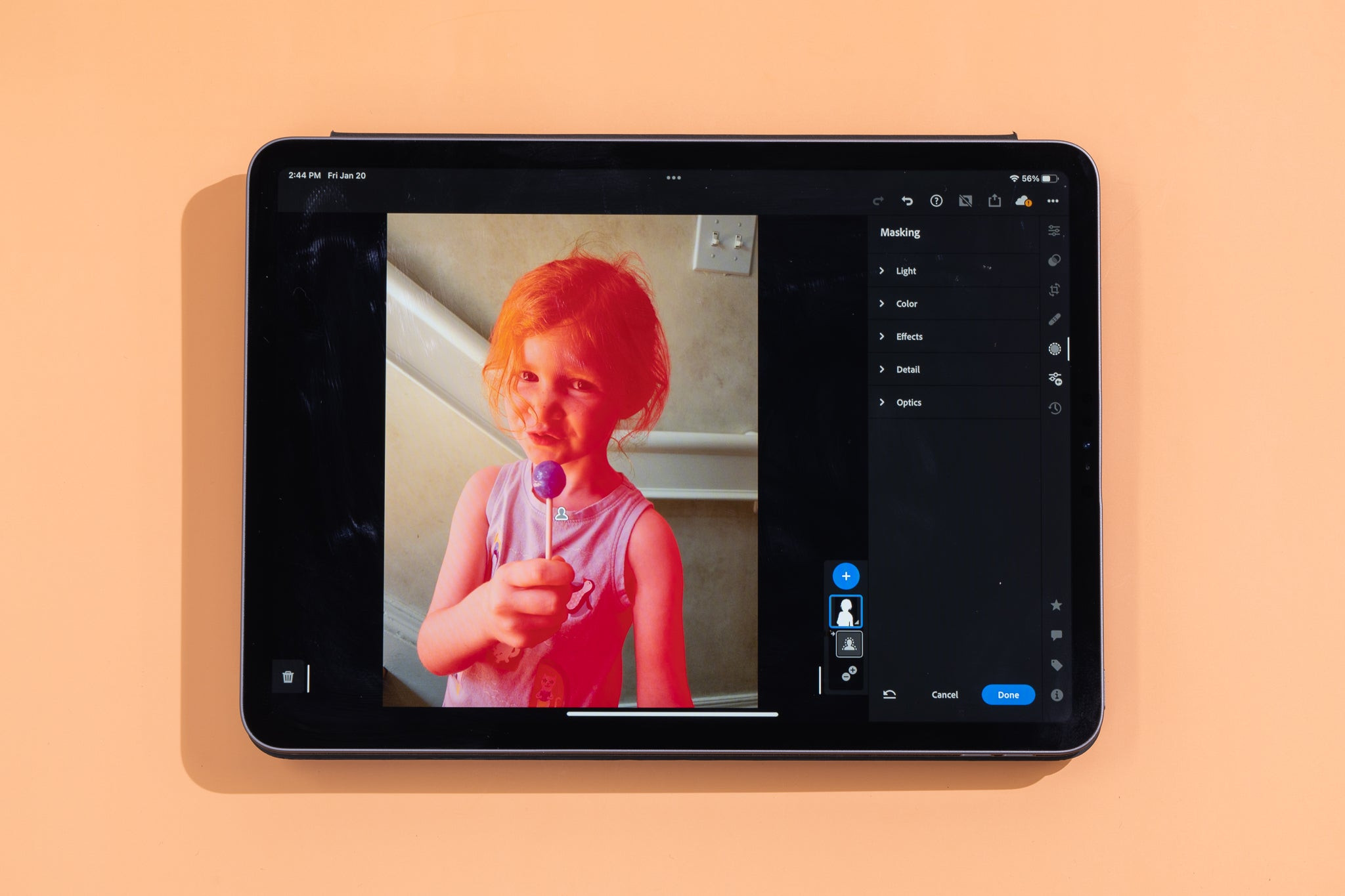In today’s digital age, our smartphones have become powerful cameras, capable of capturing breathtaking moments. However, raw photos straight out of the camera often need a little enhancement to truly shine. This is where photo editing apps come in, transforming good images into stunning visual stories. With a plethora of options available, choosing the right photo editing app can feel overwhelming. If you’re searching for the best tools to elevate your mobile photography, look no further. We’ve tested and analyzed numerous apps to bring you our top recommendation for achieving professional-looking edits right on your phone.
 A smartphone displaying an editing screen of the Adobe Lightroom app, showcasing its user interface and editing tools.
A smartphone displaying an editing screen of the Adobe Lightroom app, showcasing its user interface and editing tools.
When it comes to mobile photo editing, one app consistently rises above the rest, offering an unparalleled combination of power, flexibility, and user-friendliness: Adobe Lightroom Mobile.
Adobe Lightroom: The Premier Choice for Mobile Photo Editing

Adobe Lightroom (Android, iPhone, iPad) isn’t just a top-tier mobile photo editor; it’s a comprehensive ecosystem for photographers of all levels. Whether you’re a casual user seeking quick enhancements or a seasoned professional demanding precise control, Lightroom offers something for everyone. Available in both free and paid versions, Lightroom distinguishes itself with its extensive range of adjustments, exceptional output quality, and robust library management system.
Unmatched Features and Flexibility
Lightroom’s strength lies in its vast array of editing tools. Beyond basic adjustments like exposure, contrast, and saturation, the free version unlocks advanced functionalities such as curves, noise reduction, and dehaze. These tools, typically found in desktop-grade software, empower users to fine-tune their images with remarkable precision directly on their mobile devices. Unlike apps that primarily rely on pre-set filters, Lightroom emphasizes granular control, allowing you to shape the look and feel of your photos to your exact vision.
For users seeking even more power, the premium subscription unlocks a suite of professional-grade features, including healing and masking tools, perspective correction, and the ability to edit raw files. This upgrade transforms Lightroom into a truly mobile powerhouse, capable of handling demanding editing tasks on the go.
Superior Image Quality and Performance
In side-by-side comparisons, Lightroom consistently delivers superior results, particularly in challenging lighting conditions. Its shadow lifting capabilities are especially impressive, rescuing detail and color from underexposed areas that other apps struggle with. While its auto-fix feature might sometimes over-brighten shadows, the manual controls allow for nuanced adjustments to achieve perfectly balanced images. The app’s performance is also noteworthy; it operates smoothly even on older devices, ensuring a lag-free editing experience.
Intuitive Interface with Depth
While Lightroom boasts a wealth of features, its interface remains remarkably user-friendly. Inspired by its desktop counterpart, the mobile layout organizes tools into logical submenus accessible via icons at the bottom of the screen. This design provides a clean and uncluttered workspace, allowing you to focus on your image.
 Lightroom's editing interface on a mobile device, highlighting the icon-based menu for accessing various editing tools.
Lightroom's editing interface on a mobile device, highlighting the icon-based menu for accessing various editing tools.
Adjusting settings is intuitive; simply drag your finger along a slider. For those who demand ultimate precision, Lightroom offers micro-adjustments through tap controls and a double-tap reset feature, catering to detail-oriented editors. While newcomers might initially encounter a slight learning curve due to the depth of features, Lightroom provides interactive tutorials to guide users through various editing techniques, making it accessible to photographers of all skill levels.
Robust Library and Organization
Lightroom’s library system sets it apart from many other mobile editing apps. Instead of directly accessing your device’s camera roll, Lightroom imports photos into its own library. While this creates duplicates and consumes extra storage, it unlocks powerful organizational capabilities. You gain access to a comprehensive edit history, allowing you to revert to previous edits at any point. Furthermore, Lightroom facilitates superior organization with albums, sorting options, and filtering based on flags, ratings, and other criteria. This makes it easy to manage large photo collections and revisit editing projects later.
AI-Powered Innovation
Adobe continues to innovate within Lightroom, integrating cutting-edge AI-powered tools to streamline and enhance the editing process. Features like Generative Remove, Quick Actions, and Lens Blur leverage AI to simplify complex tasks and achieve impressive results. Generative Remove, available for subscribers, intelligently removes unwanted objects, seamlessly blending the surrounding pixels for natural-looking edits. Quick Actions utilizes AI to automatically detect subjects, backgrounds, or skies, enabling targeted adjustments with presets or manual controls. Lens Blur adds realistic depth of field effects, enhancing portraits and creating visually appealing bokeh. These AI tools, while requiring a data connection, represent a significant step forward in mobile photo editing capabilities.
Lightroom vs. The Competition
While several excellent photo editing apps are available, including Snapseed and VSCO, Lightroom distinguishes itself through its comprehensive feature set and professional-grade capabilities. Snapseed, a free app from Google, offers a solid range of tools and is praised for its ease of use. VSCO is popular for its artistic filters and film-like presets, catering to a more stylized aesthetic. However, neither app matches Lightroom’s depth of features, raw file editing capabilities (in the paid version), or organizational prowess. Lightroom provides a more complete and versatile solution for users serious about mobile photo editing.
Who is Lightroom For?
Lightroom is ideal for anyone who wants to take their mobile photography to the next level. It’s perfect for:
- Photography enthusiasts: Those passionate about photography who want powerful editing tools in their pocket.
- Social media creators: Individuals who want to create visually engaging content for platforms like Instagram and Facebook.
- Professional photographers: Working photographers who need a robust mobile editing solution for quick edits on location or for managing and reviewing images.
- Users of all skill levels: While offering advanced features, Lightroom is designed to be accessible to beginners through its intuitive interface and guided tutorials.
Pricing and Subscription Options
Lightroom offers a generous free version that includes a vast majority of its core editing tools. For users seeking advanced features, Adobe provides several subscription options:
- Lightroom Premium: Unlocks healing, masking, raw editing, and more for $5 per month or $50 per year.
- Lightroom Plan: Includes Lightroom mobile and desktop apps with 1TB of cloud storage for $12 per month.
- Photography Plan: Includes Lightroom, Lightroom Classic, and Photoshop with 20GB of cloud storage for $12 per month.
While the subscription cost might seem higher than some other apps, the value offered by Lightroom, especially for users who utilize both mobile and desktop editing workflows, is undeniable.
Pros and Cons of Adobe Lightroom Mobile
Pros:
- Unmatched range of editing tools in the free version.
- Professional-grade features in the paid version, including raw file editing and masking.
- Superior image quality and performance.
- Intuitive and user-friendly interface.
- Robust library and organization system.
- AI-powered features enhance editing workflows.
- Cross-device syncing and cloud storage with subscription plans.
Cons:
- Steeper learning curve compared to simpler filter-based apps.
- Premium features require a subscription.
- Library system creates duplicate files, consuming storage space.
- Free version requires an Adobe account.
Conclusion: Elevate Your Mobile Photography with Lightroom
For those asking “What Are The Best Photo Editing Apps?”, Adobe Lightroom Mobile stands out as the clear frontrunner. Its powerful features, exceptional image quality, and versatile workflow make it the top choice for both casual and serious mobile photographers. Whether you stick with the feature-rich free version or unlock its full potential with a subscription, Lightroom empowers you to transform your smartphone photos into stunning works of art. While it might have a slightly steeper learning curve than basic filter apps, the investment in time is well worth it for the unparalleled creative control and professional results Lightroom delivers.